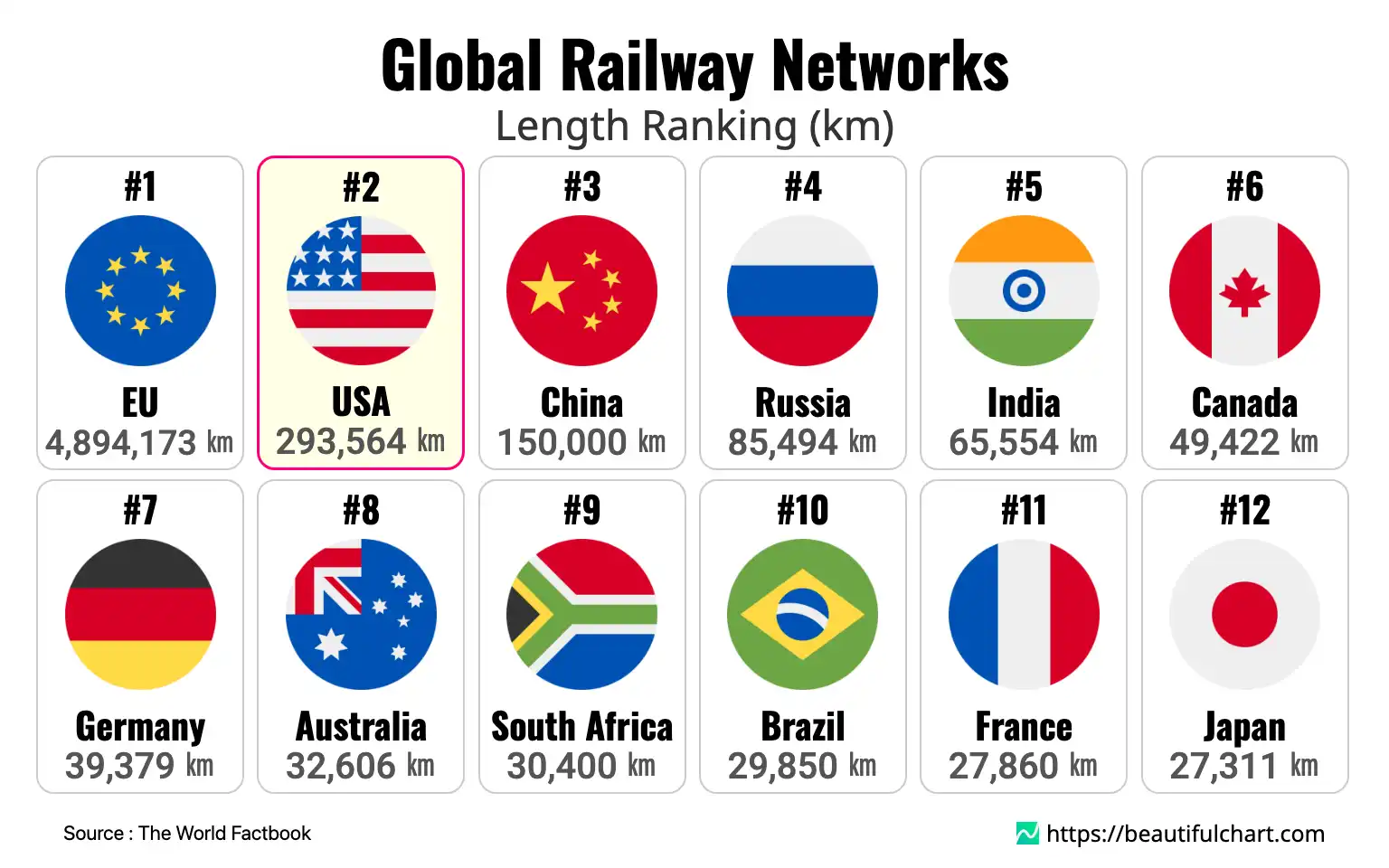A global comparison of railway networks reveals a significant concentration of infrastructure in a few key regions and countries. The European Union collectively possesses the most extensive network by a substantial margin, highlighting its integrated transport system. The United States follows in a distant second, underscoring its reliance on rail for freight and logistics across its vast territory. China, Russia, and India complete the top five, each with massive networks that are critical to their economic and social functions, though their combined length is still dwarfed by the EU's total.

Railway network length refers to the total route-kilometers of railway lines within a country or region. This measurement includes all tracks in operation, reflecting the scale and reach of a nation's rail infrastructure for transporting passengers and freight.
The distribution of railway infrastructure across the world reveals deep insights into economic development, geographic scale, and strategic priorities. The figures show a landscape dominated by a few major powers, whose networks serve as the backbone for domestic and international trade, resource distribution, and passenger movement.
The Titans of Rail: EU, USA, and China
The combined railway length of the European Union is unparalleled, a testament to decades of integration and cross-border cooperation. This extensive grid facilitates seamless trade and travel across the continent, acting as a cohesive force for its member states. It is a complex system born from the amalgamation of numerous national networks, each with its own history, but now working largely in concert to support one of the world's largest single markets.
In North America, the United States' system is a cornerstone of its economy. While less focused on passenger travel compared to Europe or Asia, its rail lines are the primary arteries for long-haul freight. They carry raw materials, agricultural products, and finished goods from coast to coast, making it a critical component of the nation's supply chain. The sheer scale of the U.S. network reflects the country's continental size and the logistical challenges of connecting its industrial and agricultural heartlands with its coastal ports.
China's position in the top three is the result of one of the most ambitious infrastructure expansions in modern history. Over the past two decades, the country has invested heavily in building out both conventional and high-speed rail lines. This expansion has been a key driver of its economic growth, connecting its populous eastern cities with developing inland regions and facilitating the rapid movement of both people and goods. The high-speed network, in particular, has revolutionized domestic travel and stands as a symbol of the nation's technological prowess.
Continental Connectors and Regional Powers
Russia's vast and sparse geography makes its railway system, including the legendary Trans-Siberian Railway, a lifeline. It is essential for connecting the European part of the country with its resource-rich territories in Siberia and the Far East. The network is vital for transporting natural resources like oil, gas, and minerals, which are the bedrock of its economy. Similarly, India's railway is the lifeblood of the nation, but with a different focus. It is one of the most intensively used networks in the world, carrying billions of passengers annually and playing an indispensable role in the daily lives of its citizens. While freight is also important, the system's primary function is affordable mass transit for its enormous population.
Beyond the top five, countries like Canada, Germany, and Australia possess significant networks tailored to their own unique needs—Canada for transcontinental freight, Germany as a central hub in Europe, and Australia for hauling minerals from remote mines to ports. The data underscores a clear correlation between the length of a country's railway system and its economic output, population density, and geographic size.
Key Takeaways
Dominance of the Top Tiers
- The European Union's collective network is the largest in the world, far surpassing any single nation.
- The United States and China hold the second and third positions, respectively, showcasing their status as continental-scale economies.
- There is a significant drop-off in network length after the top five countries, indicating a high concentration of global rail infrastructure.
Economic and Strategic Significance
- In the United States, rail is primarily a freight-driven system, essential for the national supply chain.
- India's network is one of the world's busiest in terms of passenger volume, serving as a critical mode of mass transit.
- China's rapid expansion of high-speed rail has been a major factor in its economic development and national integration.
Top Ranking
#1 EU 4,894,173 km
The European Union's railway network is the most extensive in the world, a result of the integration of its 27 member states' national systems. This vast grid is fundamental to the EU's single market, enabling efficient cross-border trade and passenger travel. It supports economic cohesion and environmental goals by promoting a shift from road to rail, reducing carbon emissions across the continent.
#2 USA 293,564 km
The United States has the second-longest railway network, which functions as the backbone of its economy. The system is heavily dominated by freight, with private companies operating extensive lines to transport raw materials, agricultural goods, and finished products over long distances. While passenger service is limited outside of key corridors, the freight rail system is crucial for the nation's supply chain and industrial output.
#3 China 150,000 km
China's railway network has undergone unprecedented expansion, making it the third-largest globally. The government has invested massively in both conventional and high-speed rail, connecting its major economic hubs and remote regions. This modern infrastructure has been a key driver of economic growth, facilitating labor mobility and the transport of goods, and includes the world's largest high-speed rail system.
#4 Russia 85,494 km
Spanning eleven time zones, Russia's railway system is a critical lifeline connecting its European territories with Siberia and the Far East. The network, which includes the famous Trans-Siberian Railway, is essential for transporting natural resources like oil, coal, and timber from remote areas to industrial centers and ports. It plays an indispensable role in both the national economy and strategic defense.
#5 India 65,554 km
India's railway network is one of the most intensively used in the world, serving as the primary mode of long-distance travel for its massive population. Known as the "lifeline of the nation," it carries over 23 million passengers daily. The system is state-owned and is undergoing modernization to increase speed, improve safety, and expand its freight capacity to further support India's growing economy.
| Rank | Name | Indicator |
|---|---|---|
1 | 4,894,173 ㎞ | |
2 | 293,564 ㎞ | |
3 | 150,000 ㎞ | |
4 | 85,494 ㎞ | |
5 | 65,554 ㎞ | |
6 | 49,422 ㎞ | |
7 | 39,379 ㎞ | |
8 | 32,606 ㎞ | |
9 | 30,400 ㎞ | |
10 | 29,850 ㎞ | |
11 | 27,860 ㎞ | |
12 | 27,311 ㎞ | |
13 | 23,389 ㎞ | |
14 | 21,733 ㎞ | |
15 | 19,461 ㎞ | |
16 | 18,475 ㎞ | |
17 | 17,866 ㎞ | |
18 | 16,636 ㎞ | |
19 | 16,390 ㎞ | |
20 | 15,489 ㎞ |





